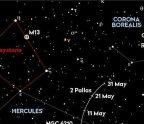CUTTING EDGE
Apr 22, 2021
4 minutes

Planets orbit around a backwards spinning star
A planetary system appears to have been pulled out of line by a neighbouring star
Our Solar System is nicely ordered. All the planets move around the Sun in more-or-less perfect circles, and all their orbits are aligned in the same plane – like marbles rolling around the same dinner plate. This is known as the plane of the ecliptic, and it’s the reason why the Sun, the Moon and all the planets appear to move along the same narrow band in our skies – the zodiac. The Sun’s own rotation is aligned in the same way (well, it has an axial tilt of just 7°) so that the solar equator lies along the plane
You’re reading a preview, subscribe to read more.
Start your free 30 days





